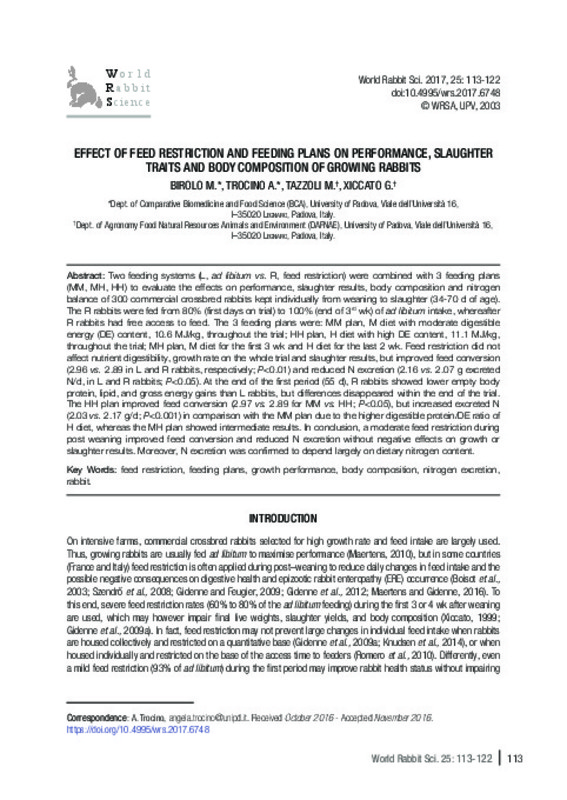JavaScript is disabled for your browser. Some features of this site may not work without it.
Buscar en RiuNet
Listar
Mi cuenta
Estadísticas
Ayuda RiuNet
Admin. UPV
Effect of feed restriction and feeding plans on performance, slaughter traits and body composition of growing rabbits
Mostrar el registro sencillo del ítem
Ficheros en el ítem
| dc.contributor.author | Birolo, Marco
|
es_ES |
| dc.contributor.author | Trocino, Angela
|
es_ES |
| dc.contributor.author | Tazzoli, Marco
|
es_ES |
| dc.contributor.author | Xiccato, Gerolamo
|
es_ES |
| dc.date.accessioned | 2017-07-10T07:36:41Z | |
| dc.date.available | 2017-07-10T07:36:41Z | |
| dc.date.issued | 2017-06-28 | |
| dc.identifier.issn | 1257-5011 | |
| dc.identifier.uri | http://hdl.handle.net/10251/84796 | |
| dc.description.abstract | [EN] Two feeding systems (L, ad libitum vs. R, feed restriction) were combined with 3 feeding plans (MM, MH, HH) to evaluate the effects on performance, slaughter results, body composition and nitrogen balance of 300 commercial crossbred rabbits kept individually from weaning to slaughter (34-70 d of age). The R rabbits were fed from 80% (first days on trial) to 100% (end of 3rd wk) of ad libitum intake, whereafter R rabbits had free access to feed. The 3 feeding plans were: MM plan, M diet with moderate digestible energy (DE) content, 10.6 MJ/kg, throughout the trial; HH plan, H diet with high DE content, 11.1 MJ/kg, throughout the trial; MH plan, M diet for the first 3 wk and H diet for the last 2 wk. Feed restriction did not affect nutrient digestibility, growth rate on the whole trial and slaughter results, but improved feed conversion (2.96 vs. 2.89 in L and R rabbits, respectively; P<0.01) and reduced N excretion (2.16 vs. 2.07 g excreted N/d, in L and R rabbits; P<0.05). At the end of the first period (55 d), R rabbits showed lower empty body protein, lipid, and gross energy gains than L rabbits, but differences disappeared within the end of the trial. The HH plan improved feed conversion (2.97 vs. 2.89 for MM vs. HH; P<0.05), but increased excreted N (2.03 vs. 2.17 g/d; P<0.001) in comparison with the MM plan due to the higher digestible protein/DE ratio of H diet, whereas the MH plan showed intermediate results. In conclusion, a moderate feed restriction during post weaning improved feed conversion and reduced N excretion without negative effects on growth or slaughter results. Moreover, N excretion was confirmed to depend largely on dietary nitrogen content. | es_ES |
| dc.description.sponsorship | This study was funded by the Ministero dell’Istruzione dell’Università e della Ricerca (Project COD.60A08–7188/12). | |
| dc.language | Inglés | es_ES |
| dc.publisher | Universitat Politècnica de València | |
| dc.relation.ispartof | World Rabbit Science | |
| dc.rights | Reserva de todos los derechos | es_ES |
| dc.subject | Feed restriction | es_ES |
| dc.subject | Feeding plans | es_ES |
| dc.subject | Growth performance | es_ES |
| dc.subject | Body composition | es_ES |
| dc.subject | Nitrogen excretion | es_ES |
| dc.subject | Rabbit | es_ES |
| dc.title | Effect of feed restriction and feeding plans on performance, slaughter traits and body composition of growing rabbits | es_ES |
| dc.type | Artículo | es_ES |
| dc.date.updated | 2017-07-10T07:29:10Z | |
| dc.identifier.doi | 10.4995/wrs.2017.6748 | |
| dc.relation.projectID | info:eu-repo/grantAgreement/MIUR//COD.60A08–7188%2F12/ | es_ES |
| dc.rights.accessRights | Abierto | es_ES |
| dc.description.bibliographicCitation | Birolo, M.; Trocino, A.; Tazzoli, M.; Xiccato, G. (2017). Effect of feed restriction and feeding plans on performance, slaughter traits and body composition of growing rabbits. World Rabbit Science. 25(2):113-122. https://doi.org/10.4995/wrs.2017.6748 | es_ES |
| dc.description.accrualMethod | SWORD | es_ES |
| dc.relation.publisherversion | https://doi.org/10.4995/wrs.2017.6748 | es_ES |
| dc.description.upvformatpinicio | 113 | es_ES |
| dc.description.upvformatpfin | 122 | es_ES |
| dc.type.version | info:eu-repo/semantics/publishedVersion | es_ES |
| dc.description.volume | 25 | |
| dc.description.issue | 2 | |
| dc.identifier.eissn | 1989-8886 | |
| dc.contributor.funder | Ministero dell'Istruzione dell'Università e della Ricerca, Italia | |
| dc.description.references | Blas, C. de, & Mateos, G. G. (s. f.). Feed formulation. Nutrition of the rabbit, 222-232. doi:10.1079/9781845936693.0222 | es_ES |
| dc.description.references | Di Meo C., Bovera F., Marono S., Vella N., Nizza A. 2007. Effect of feed restriction on performance and feed digestibility in rabbits. It. J. Anim. Sci., 6: 765-767. | es_ES |
| dc.description.references | ERM/AB–DLO. 1999. Establishment of Criteria for the assessment of the nitrogen content of animal manures, European Commission, Final Report, Luxembourg. | es_ES |
| dc.description.references | Fernández Carmona J., Pascual J.J., Cervera C. 2000. The use of fats in rabbit diets. In: Proc. 7th World Rabbit Congress, 5-7 July, 2000, Valencia, Spain. World Rabbit Sci., 8, suppl. 1, vol. C, 29-59. | es_ES |
| dc.description.references | Gidenne T., Aubert C., Drouilhet L., Garreau H. 2013a. Feed efficiency in rabbit breeding: technico-economical and environmental impacts. In: Proc. 15èmes Journ. Rech. Cunicole, 26-27 November, 2013, Le Mans, France, 1-13. | es_ES |
| dc.description.references | Marlier D., Dewree R., Delleur V., Licois D., Lassence C., Poulipoulis A., Vindevogel H. 2003. A review of the major causes of digestive disorders in the European rabbit. Ann. Med. Vet., 147: 385-392. | es_ES |
| dc.description.references | Mertens D.R. 2002. Gravimetric determination of amylase-treated neutral detergent fiber in feeds with refluxing in beakers or crucibles: collaborative study. J. AOAC Int., 85: 1217-1240. | es_ES |
| dc.description.references | XICCATO, G. (2010). FEEDING AND MEAT QUALITY IN RABBITS: A REVIEW. World Rabbit Science, 7(2). doi:10.4995/wrs.1999.383 | es_ES |
| dc.description.references | Xiccato G., Cinetto M., Dalle Zotte A. 1992. Effetto del livello nutritivo e della categoria di conigli sulla digeribilità degli alimenti e sul bilancio azotato. Zoot. Nutr. Anim., 18: 35-43. | es_ES |
| dc.description.references | Xiccato G., Trocino A., Sartori A., Queaque P.I. 2003. Effect of weaning diet and weaning age on growth, body composition and caecal fermentation of young rabbits. Anim. Sci., 77: 101-111. https://doi.org/10.1017/S1357729800053704 | es_ES |








